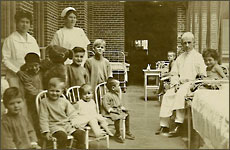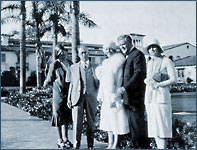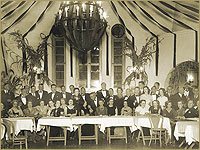M.D.s and D.O.s in Early California


Interviews
Early medical womenA description of the challenges in establishing a D.O. practice during the pioneering years in California was recorded by Irma West, M.D., based on an interview she had with Sara Faustman in the 1990s. Dr. West sent the following description to Dr. Seffinger per email in June 2005. "Louise C. Heilbron, D.O. (1873-1933) was a member of a prominent pioneer family and the best known osteopath in the State. From time to time she lived in the Heilbron mansion still standing at 8th and O streets. She was born in Sacramento, the oldest of 10 children, but moved to San Diego at age 15. She always wanted to be a doctor, but the death of her father when her youngest sibling was an infant called upon her to stay close to home, so she opted to attend the California College of Osteopathy [actually named Pacific School of Osteopathy in 1900], graduating in 1900. Dr. Heilbron's first practice was in San Diego where she is credited with organizing the PTA and becoming a charter member of the San Diego Business and Professional Women. She moved to San Francisco just in time for the earthquake to demolish her office and home. Upon returning to Sacramento she maintained a busy practice for over 20 years until her death following a ruptured appendix. She was co-founder of the Sacramento Soroptimist International and chair on public health matters for the California Osteopathic Association. She is buried in Sacramento's Old City Cemetery." Dr. West found additional information about Louise Heilbron, D.O. in records maintained at the Sacramento Old City Cemetery. Louise Heilbron, D.O. appeared in a booklet entitled �Walking Tour of Medical Pioneer Grave Sites�, which Dr. West prepared for the Sacramento Sierra Valley Medical Society. As this booklet is out of print, the brief biography above was published in�Sacramento Sierra Valley Medicine,�March/April 2004, page 30, entitled �Early Medical Women�. Professional developmentAs osteopathic physicians and surgeons became increasingly established, they aimed to secure their profession in California by re-establishing their separate licensing board to regulate their practice. Thus, in 1922, the State measure No. 20, entitled �Osteopathic Initiative Act�, was placed on the ballot for California voters. The majority of allopathic medical doctors as well as from some osteopathic doctors in the state Osteopathic physicians in California opposed the measure. The California Medical Association (CMA), the state�s major newspaper, and the American Osteopathic Association opposed the measure as well. The CMA did not want two separate licensing boards for physicians and surgeons, presumably to retain their dominance. The AOA opposed the measure because the licensing examination required stringent education and training that would be difficult to obtain for D.O.s in states other than California. Yet, the Osteopathic Initiative Act passed by over a 100,000 vote margin. Thus, in 1922 a separate board was established, the California Board of Osteopathic Examiners. The board was given the power to approve colleges and hospitals, to examine applicants for osteopathic licensure, and to provide jurisdiction over all osteopathic physicians and surgeons with California certificates. The board still exists, though it is now called the Osteopathic Medical Board of California, residing alongside the Medical Board of California under the auspices of the state Department of Consumer Affairs. In the 1920s and 1930s, as the profession was protected through its own regulatory authority, it expanded through increased opportunities for education and training, and through continued political activities at the state and national level. Improved licensure conditions attracted an increased number of students to enroll at the College of Osteopathic Physicians & Surgeons (since 1914 the final name of the college). Larger revenues made possible a new science building and laboratories for the study of anatomy and physiology, bacteriology, chemistry, pathology and histology. This section covers osteopathy�s growth and its effect on the relationship between the osteopathic and allopathic professional organizations from the late 1920s to the late 1950s. More detailed documentation can be found in the book �The Merger: M.D.s and D.O.s in California�, published by Xlibris in 2008. Recollections by Dain Tasker, D.O.Dain Tasker, D.O. looked at his half century of practicing and promoting osteopathy in California as the �Fifty golden years�. His account provides an exemplar of osteopathic professional development during the beginning years of osteopathy in California. Since he spent most of his career to establish osteopathy in California, his brief summary illuminates those pioneering years (chapter 66 of Dain Tasker�s unpublished manuscript, �A History of Osteopathy in California�). Dain Tasker�s mother was a practical nurse who later became an osteopathic physician herself. He briefly wrote about his adolescence and high school years, mainly to point out his interest in anatomy, apparent already in those early years. For health reasons he moved to Riverside in California in 1892 and worked as a ranch hand, saving his money to become a doctor. A letter by his mother, describing osteopathy, influenced Dain Tasker deeply in that he changed his plans from becoming an M.D. to studying osteopathy. He graduated from the Pacific College of Osteopathy in 1898 and immediately joined the faculty of that college. He did post-graduate work at the American School of Osteopathy in Kirksville where he also joined the faculty. He married Cora Newell, D.O. and they practiced together. Dr. Dain Tasker was instrumental in organizing the California Osteopathic Association. The purpose of the COA was to establish better practice rights. He wrote that �he finally succeeded in getting a law through that allowed for a State Board of Examiners.� Dr. Tasker became president of the first Board of Osteopathic Examiners. In 1907 a composite Board was enacted and Dr. Tasker became its president in 1909. For 21 years he served on various Boards of Osteopathic Medical Examiners in California. He also was President of COA in 1901 and 1907. He taught Principles of Osteopathy at the Pacific College and published his lectures, with illustrations, in 1903. This book went through five editions and served as text book in all recognized colleges. During WWI Dr. Tasker served on a national committee of the AOA to obtain recognition for D.O.s by the Army Medical Corps. He realized the need for more osteopathic hospitals and served as a roentgenologist at Wilshire Hospital in Los Angeles from 1925 to 1947. His hobby was color photography. Many of his X-ray photos of flowers resembled delicate etchings. Patient care in osteopathic hospitalsIn California generally, D.O.s were not allowed to train or see patients in hospitals controlled or owned by allopathic physicians. Especially relatively large facilities adhered to this regulation, while smaller hospitals quite often had dual staff privileges. �Dual staff� entailed an M.D. staff and a separate D.O. staff working side by side. Privileges were granted by each staff for their own members. In large M.D.-operated facilities, D.O.s were usually not permitted to practice. This segregation of the two equally licensed medical professions lasted until the Hill Burton Act in 1945 required open access for licensed services at hospitals built with federal funds. Since many hospitals in California were not built with federal funds, hospital segregation continued to be a major barrier to professional growth and practice. In the late 1920s, the Los Angeles Board of Supervisors approved an expansion of the Los Angeles County Hospital. A new building, called Unit I, was added and the old building, known then as Unit II, was given to the osteopathic profession. Unit I comprised the greater part of the hospital and was operated by allopathic medicine. USC medical school provided training at Unit I and COP&S at Unit II. Senior students at COP&S spent one trimester at Unit II. They also learned at Monte Sano Hospital and at City Maternity Services. Unit II existed until the 1950s when the osteopathic physicians were able to have their own hospital, called the Los Angeles County Osteopathic Hospital. While Unit II at the L.A. County Hospital helped to serve the needs of patients who lived near the downtown area, osteopathic physicians in the surrounding communities needed additional access to hospital beds for their patients. In 1940, four of 27 nation-wide osteopathic hospitals approved by AOA were located in California: Doctors Hospital in Los Angeles, Unit II of the Los Angeles County Hospital, Magnolia Hospital in Long Beach, and Monte Sano Hospital in Los Angeles. In addition, there were several other osteopathic hospitals, albeit not AOA approved at that time. Several osteopathic hospitals were founded by graduates of COP&S in this time period. Howard Norcross, D.O., a graduate of COP&S in 1936, founded and owned Doctors Hospital in 1939. Howard�s brother was a chiropractor and wanted to have a hospital for referring his patients and those of his colleagues, if needed. Doctor�s Hospital had an internship and residency training program for D.O.s. until 1960. James Taylor, M.D. and a graduate of COP&S in 1958, practiced at Bay Harbor Hospital for 30 years. In 1943, Burbank Community Hospital was located in the city of Burbank. Dr. MacCracken recalls it as �one of our finest hospitals�. After the merger it became Thompson Memorial Hospital. The facility no longer exists, though. The Merrill Sanitarium was a psychiatric hospital that employed the uniquely osteopathic approach to the care of the mentally ill. Merrill Sanitarium provided a combination of environmental, cognitive and osteopathic manipulative therapies to patients. Edward Merrill, D.O. also practiced at Monte Sano Hospital in the Los Angeles area, together with Louis Chandler, D.O. Monte Sano Hospital and Sanitarium served as an osteopathic institution for nearly 50 years. Built in 1923 on a hillside at the corner of Glendale Avenue and Waverly Drive in Los Angeles, the three-story Spanish-style hospital, with terraces for each room, provided its 50 patients with a mind-expanding panoramic view of the San Gabriel Mountains. As the first modern osteopathic hospital in Southern California, it was envisioned as a �perfect health recuperation resort� on its �hill of health�. It outlasted the merger between M.D.s and D.O.s in the 1960s and only closed down in the 1970s. Further information about historic osteopathic hospitals and those with dual medical services in California can be found in chapter 3 of the book �The Merger: M.D.s and D.O.s in California�, published by Xlibris in 2008. |